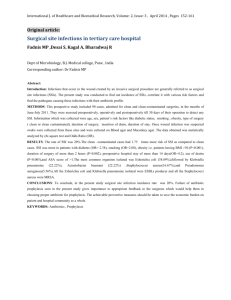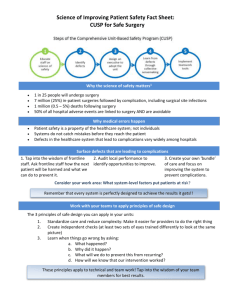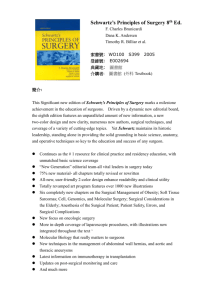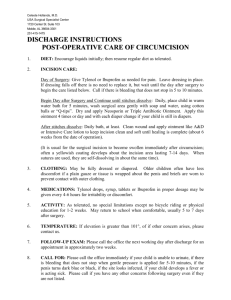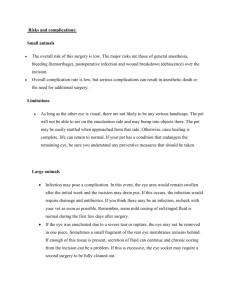Surgical-site-infection-20-Nov-2014
advertisement
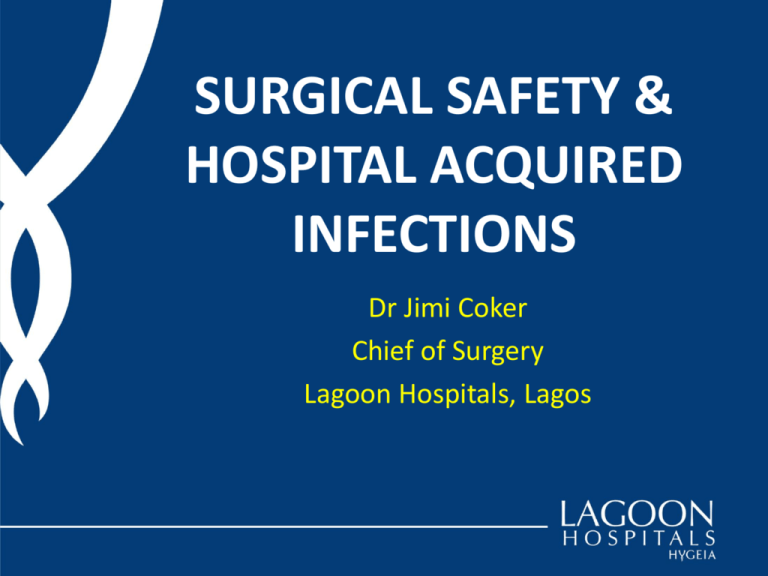
SURGICAL SAFETY & HOSPITAL ACQUIRED INFECTIONS Dr Jimi Coker Chief of Surgery Lagoon Hospitals, Lagos Overview • • • • • • • • • Define Hospital Associated Infections Surgical site infection (SSI) Wound classification Risk stratification of SSI Care bundles Antibiotic prophylaxis WHO Safety check list SSI surveillance Summary Hospital Acquired Infection • Nosocomial infection • Infections occurring more than 48 hours after hospital admission • Evidence of poor quality health service delivery • Avoidable cost – Increased ALOS – Further interventions – Delayed return to work Hospital Acquired Infections relating to surgery 1. Surgical site infections 1. Urinary Tract Infection (CAUTI) 2. Indwelling Catheter/cannula Infection 3. Ventilated Associated Pneumonia Hospital Acquired Infections relating to surgery 1. Surgical site infections 1. Urinary Tract Infection (CAUTI) 2. Indwelling Catheter/cannula Infection 3. Ventilated Associated Pneumonia Joseph Lister (1827 – 1912) • 1883-1897 • British surgeon at GRI • Used Carbolic Acid (Phenol) to clean hands, instruments and wipe on surgical wounds • Drastically decreased infections. Surgical Site Infections (SSI) • Purulent discharge, abscess or spreading cellulitis at surgical site up to one month after surgery. • 3rd most common hospital infection • Incidence : 0.5 – 15% • Incisional – Superficial – Deep • Organ Space – Generalized (peritonitis) – Abscess SSI transmission • Exogenous – Surgeons, nurses and other staff – Medical equipment – Other patients • Endogenous – Skin flora – Other infections in patient – Blood transfusion (rare) SSI – Wound Classification • • • • Class 1 = Clean Class 2 = Clean contaminated Prophylactic antibiotics Class 3 = Contaminated indicated Class 4 = Dirty infected Therapeutic antibiotics Mangram AJ et al. Infect Control Hosp Epidemiol. 1999;20:250-278. Types of Surgery Clean Hernia repair breast biopsy 1.5% CleanContaminated Cholecystectomy Elective bowel resection 2-5% Contaminated Emergency bowel resection 5-30% Dirty/infected Perforation, abscess 5-30% SSI – Risk Stratification NNIS Project Independent variables associated with SSI risk 1. Contaminated or dirty/infected wound classification 2. ASA > 2 3. Length of operation > 75th percentile of the specific operation being performed NNIS=National Nosocomial Infections Surveillance. NNIS. CDC. Am J Infect Control. 2001;29:404-421. Host Risk Factors • • • • • • • • Diabetes mellitus Hypoxaemia Hypothermia Leukopenia Nicotine (tobacco smoking) Immunosuppression Malnutrition Poor skin hygiene Perioperative Risk Factors • • • • • • • • Operative site shaving Breaks in operative sterile technique Improper antimicrobial prophylaxis Prolonged hypotension Contaminated operating room Poor wound care postoperatively Hyperglycemia Wound closure technique Operative Antibiotic Prophylaxis • Decreases bacterial counts at surgical site • Given within 60 minutes prior to starting surgery (knife to skin) • Repeat dose for longer surgery (T 1/2) • Do not continue beyond 24 hours • Determinants – prevailing pathogens, antibiotic resistance, type of surgery • Not a substitute for aseptic surgery or good technique Preop • Scrub – Duration? With what? • Skin preparation – Iodophors, chlorahexadine, or alcohol • Hair removal – Night before? Clipper vs razor • Antiseptic showering – Reduce skin flora only Care bundle: • A grouping of best practices that individually improve care, but when applied together result in substantially greater improvement. • Science behind the bundle elements is well established – the standard of care. • Bundle element compliance can be measured as “ yes/no” for audit Surgical Site Infection Prevention Bundle Components 1. Prophylactic antibiotic given within one hour prior to surgical incision 2. Appropriate prophylactic antibiotic selection for surgical patients 3. Prophylactic antibiotics discontinued within 24 hours after surgery end time (48 hours for cardiac surgery) 4. Cardiac surgery patients with controlled 6 A.M. postoperative serum blood glucose Surgical Site Infection Prevention Bundle Components 5. Surgery patients with appropriate hair removal 6. Surgery Patients with Perioperative Temperature Management – maintaining normothermia 7. Urinary Catheter removal on postoperative Day 1 or 2 with day of surgery being day zero. Other SSI Prevention Measures* • Protect closed incision with sterile dressing for 24-48 hours postoperatively • Maintain adequate/recommended ventilation processes in the operating rooms *CDC Guideline for Prevention of Surgical Site Infections, 1999 Timing of prophylaxis • Intravenous antibiotics should be given within 60 minutes before skin incision and as close to time of incision as practically possible (N Engl J Med 1992;326:281-6 & Ann Surg 2008;247:918 - 926) • For caesarian section it can be given pre-incision or after cord clamping • Single dose with long-enough half-life to achieve activity for duration of operation Safe Surgery Saves Lives What problems does this checklist address? Before skin incision: ¹ Bratzler, The American Journal of Surgery, 2005. ² Classen, New England Journal of Medicine, 1992. • Minimizing risk of infection – Giving antibiotics within one hour before incision can cut the risk of surgical site infection by 50%¹, ² – In the eight evaluation sites, failure to give antibiotics on time occurred in almost one half of surgical patients who would otherwise benefit from timely administration Results – All Sites Baseline Checklist P value Cases 3733 3955 - Death 1.5% 0.8% 0.003 Any Complication 11.0% 7.0% <0.001 SSI 6.2% 3.4% <0.001 Unplanned Reoperation 2.4% 1.8% 0.047 Haynes et al. A Surgical Safety Checklist to Reduce Morbidity and Mortality in a Global Population. New England Journal of Medicine 360:491-9. (2009) SSI surveillance at Lagoon Hospitals Summary • SSI is a major problem in surgical patients • Significant morbidity/mortality and expense • Prophylactic antibiotics, ASA grade and timely surgery important risk factors • WHO Safety checklist proven all over the world – highly recommended • Importance of SSI surveillance in hospitals • Safe surgery saves lives!
